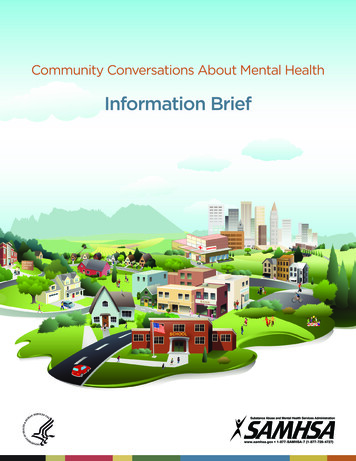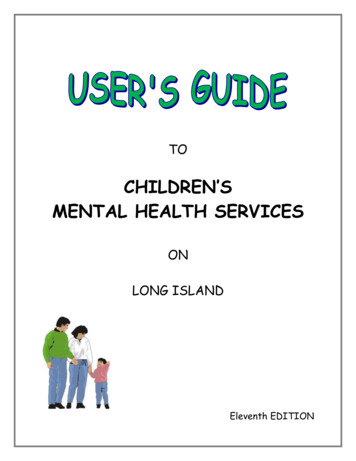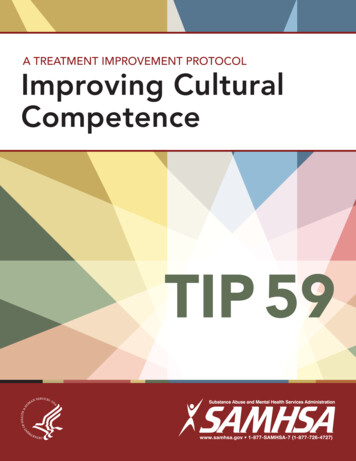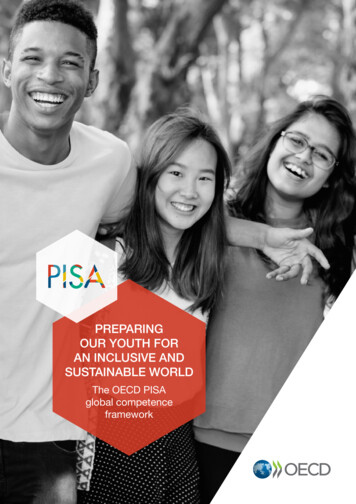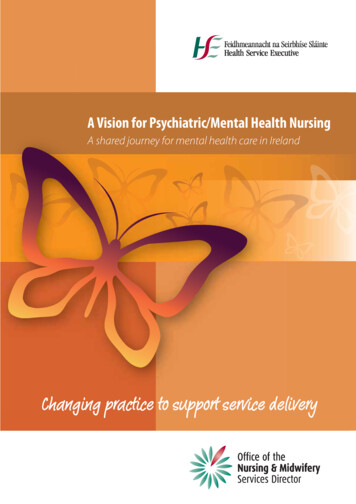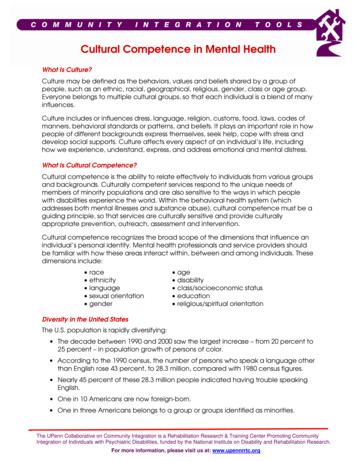
Transcription
Cultural Competence in Mental HealthWhat Is Culture?Culture may be defined as the behaviors, values and beliefs shared by a group ofpeople, such as an ethnic, racial, geographical, religious, gender, class or age group.Everyone belongs to multiple cultural groups, so that each individual is a blend of manyinfluences.Culture includes or influences dress, language, religion, customs, food, laws, codes ofmanners, behavioral standards or patterns, and beliefs. It plays an important role in howpeople of different backgrounds express themselves, seek help, cope with stress anddevelop social supports. Culture affects every aspect of an individual’s life, includinghow we experience, understand, express, and address emotional and mental distress.What Is Cultural Competence?Cultural competence is the ability to relate effectively to individuals from various groupsand backgrounds. Culturally competent services respond to the unique needs ofmembers of minority populations and are also sensitive to the ways in which peoplewith disabilities experience the world. Within the behavioral health system (whichaddresses both mental illnesses and substance abuse), cultural competence must be aguiding principle, so that services are culturally sensitive and provide culturallyappropriate prevention, outreach, assessment and intervention.Cultural competence recognizes the broad scope of the dimensions that influence anindividual’s personal identity. Mental health professionals and service providers shouldbe familiar with how these areas interact within, between and among individuals. Thesedimensions include: race ethnicity language sexual orientation gender age disability class/socioeconomic status education religious/spiritual orientationDiversity in the United StatesThe U.S. population is rapidly diversifying: The decade between 1990 and 2000 saw the largest increase – from 20 percent to25 percent – in population growth of persons of color. According to the 1990 census, the number of persons who speak a language otherthan English rose 43 percent, to 28.3 million, compared with 1980 census figures. Nearly 45 percent of these 28.3 million people indicated having trouble speakingEnglish. One in 10 Americans are now foreign-born. One in three Americans belongs to a group or groups identified as minorities.The UPenn Collaborative on Community Integration is a Rehabilitation Research & Training Center Promoting CommunityIntegration of Individuals with Psychiatric Disabilities, funded by the National Institute on Disability and Rehabilitation Research.For more information, please visit us at: www.upennrrtc.org
Cultural Competence in Mental HealthThe diversity that exists within groups is often overlooked. For example:oThe term Asian American includes people from a variety of nations, such asAfghanistan, China, India, Syria and Japan. It includes both immigrants and thosewhose families have lived in the United States for generations.oThe term African American implies that 33.9 million people share certaincharacteristics because of their ties with some of the 797 million people in Africa, wholive in 54 different countries and speak some two thousand different languages.oThe term Native American includes people who may be of unmixed ancestry orwhose Native American lineage is only a fraction of their backgrounds, who maytrace their roots to any of more than 500 different tribes, and who may or may notidentify with tribal culture.oAccording to 2006 Census Bureau estimates, some 44.3 million Americans wereidentified as Hispanic. Within this “group,” 64 percent were of Mexican background, 9percent were of Puerto Rican background, 3.5 percent Cuban, 3 percent Salvadoranand 2.7 percent Dominican. The remainder are of some other Central American,South American, or other Hispanic or Latino origin.With the increasing diversity of the U.S. population, mental health service providers mustbe aware of the influences that culture has on psychological processes, mental illnesses,and the ways that people seek help. They must also be aware of the variety withingroups.Disparities in Mental Health ServicesThe Surgeon General’s report Mental Health: Culture, Race and Ethnicity discussesdisparities in behavioral health services for members of racial and ethnic minoritypopulations. People in these populations: are less likely to have access to available mental health services; are less likely to receive necessary mental health care; often receive a poorer quality of treatment; and are significantly underrepresented in mental health research.Members of racial minority groups, including African Americans and Latinos, underusemental health services and are more likely to delay seeking treatment. Consequently, inmost cases, when such individuals seek mental health services they are at an acutestage of illness. This delay can result in a worsening of untreated illness and an increase ininvoluntary services.Generally, rates of mental disorders among people in most ethnic minority groups aresimilar to rates for Caucasians. However, members of minority populations are more likelyto experience factors – such as racism, discrimination, violence and poverty – that mayexacerbate mental illnesses.The UPenn Collaborative on Community Integration is a Rehabilitation Research & Training Center Promoting CommunityIntegration of Individuals with Psychiatric Disabilities, funded by the National Institute on Disability and Rehabilitation Research.For more information, please visit us at: www.upennrrtc.org
Cultural Competence in Mental HealthCultural disparities include the following:oFor decades, studies have shown that African Americans are more likely to bemisdiagnosed with schizophrenia than any other ethnic group. Reasons for this remainunclear.oA protein that metabolizes several antidepressant medications is less active in East Asians.This increases the risk of higher blood levels of medication and more side effects withinmembers of this population, indicating that everyone doesn’t respond to and metabolizemedication in the same way and at the same rate.oResearch on Native Americans and Alaskan Natives is limited, but existing studies suggestthat members of these populations experience a disproportionate percentage of mentalhealth problems and disorders. For example, the suicide rate among Native Americansand Alaskan Natives is 50 percent higher than the national rate.Cultural Barriers to Mental Health CareCultural barriers that prevent members of minority populations from receiving appropriatecare include: mistrust and fear of treatment; alternative ideas about what constitutes illness and health; language barriers and ineffective communication; access barriers, such as inadequate insurance coverage; and a lack of diversity in the mental health workforce.Cultural Biases and StereotypesIn general, discrimination refers to the hostile or negative feelings of one group of peopletoward another. It can cause bias in service provision and can prevent people fromseeking help. Cultural competency must address the biases and stereotypes that areassociated with an individual’s culture and various identities.Forms of discrimination include:racism: prejudice or discrimination based on a person’s race, or on the belief that onerace is superior to another;ageism: bias toward an individual or group based on age. For example, young peoplemay be stereotyped as immature and irresponsible; older adults may be called slow,weak, dependent and senile;sexism: discrimination or prejudice based on gender;heterosexism: prejudice against people who are gay, lesbian, bisexual, transgender, orintersex. It is also the assumption that all people are heterosexual and that heterosexualityis correct and normal;The UPenn Collaborative on Community Integration is a Rehabilitation Research & Training Center Promoting CommunityIntegration of Individuals with Psychiatric Disabilities, funded by the National Institute on Disability and Rehabilitation Research.For more information, please visit us at: www.upennrrtc.org
Cultural Competence in Mental Healthhomophobia: the fear and/or dislike of homosexual people or homosexuality;classism: any form of prejudice or oppression against people who are members of (or whoare perceived as being similar to those who are members of) a lower social class; andreligious intolerance: an inability or unwillingness to tolerate another’s beliefs or practices.Mental health professionals and service providers must be aware of how stereotypes andstigma influence not only their clients but also their own thoughts and views of others.How to Incorporate Cultural Competency Standards into PracticeMental health professionals and service providers can improve their cultural competenceby taking the following steps: Use open-ended questions to identify each person’s unique cultural outlook. Re-evaluate intake and assessment documentation, as well as policies andprocedures, to be more inclusive. Employ qualified mental health workers who are fluent in the languages of thegroups being served. Understand the cultural biases of staff and provide training to address educationalneeds. Understand the cultural biases in program design. Identify resources, such as natural supports, within the community that will help anindividual recover. Design and implement culturally sensitive treatment plans. Evaluate procedures and programs for cultural sensitivity and effectiveness. Survey clients and workers to elicit their understanding of cultural competence andculturally competent practice.An Example of Cultural Competence in Practice: A Community-Based Intervention forElderly Chinese AmericansDepression and dementia are the most common forms of mental illness in older adults.Depression, often associated with physical illness or disability, increases health care costsand can lead to suicide.“Chinese elders typically don’t seek help for depression and other mentaldisorders,” said Sandy Chen Stokes, a nurse and geriatric specialist at ElCamino Hospital’s Older Adult Transitions (OATS), an outpatient counselingservice (in Mountain View, California). “ You go along with what your culturetells you: tough it out or let time heal the problem. They don’t knowdepression can be treated (Some) end up as an inpatient or in a lockedfacility” (Cloutman, 2001).The UPenn Collaborative on Community Integration is a Rehabilitation Research & Training Center Promoting CommunityIntegration of Individuals with Psychiatric Disabilities, funded by the National Institute on Disability and Rehabilitation Research.For more information, please visit us at: www.upennrrtc.org
Cultural Competence in Mental HealthStokes began an outreach program by first disseminating information about depression in Chinese-language newspapers, radio and television programs. With a gift from ananonymous donor, Stokes purchased translation devices so that Chinese clients could beintegrated into an English-speaking counseling group.ConclusionThe mental health system is slowly improving, but large gaps in services still exist. Whenyou are seeking and/or providing mental health services, it is good to understand thatcultural differences influence every individual, both provider and client. With the propertraining for mental health workers and educational materials for members of minoritypopulations, culturally sensitive services can be effective in treating and possiblypreventing episodes of acute mental illness.E-ResourcesAmerican Psychological Association: Guidelines on Multicultural Education, Training,Research, Practice, and Organizational Change for idelines/formats.htmlHogg Foundation for Mental Health: Cultural Competency: A Practical Guide for MentalHealth Service Providers http://www.hogg.utexas.edu/PDF/Saldana.pdfNational Center for Cultural cchd/nccc/National Mental Health Association (now Mental Health America): Cultural and LinguisticCompetency in Mental Health Systems http://www1.nmha.org/position/ps38.cfmNew York City Department of Health and Mental Hygiene, Cultural CompetenceWebsites – Mental Health: priorityresources.pdfRainbow Heights: Guidelines for effective and culturally competent treatment withlesbian, gay, bisexual, and transgender people living with mental illness: Excerpted fromRosenberg , S., Rosenberg, J., Huygen, C., and Klein, E. (2005). No need to hide: Out ofthe closet and mentally ill, Best practices in mental health: An international journal, 1, 7285. nce Abuse and Mental Health Services Administration: Factsheets on specific racesand ethnicities: bstance Abuse and Mental Health Services Administration: Culturally specific mentalhealth resources: e UPenn Collaborative on Community Integration is a Rehabilitation Research & Training Center Promoting CommunityIntegration of Individuals with Psychiatric Disabilities, funded by the National Institute on Disability and Rehabilitation Research.For more information, please visit us at: www.upennrrtc.org
Cultural Competence in Mental HealthReferencesAtdjian, S., & Vega, W. A. (2005). Disparities in Mental Health Treatment in U.S. Racial andEthnic Minority Groups: Implications for Psychiatrists. Psychiatric Services, 56(12), 16001602.Betancourt, J. R., Green, A. R., Carrillo, J. E., Ananeh-Firempong II, O. (2003). DefiningCultural Competence: A Practical Framework for Addressing Racial/Ethnic Disparities inHealth and Health Care. Public Health Reports, 118, 293-302.Chavez, N., & Arons, B. (2001). Cultural Competence Standards in Managed Care MentalHealth Services: Four Underserved/Underrepresented Racial/Ethnic Groups. SubstanceAbuse and Mental Health Services Administration, National Mental Health InformationCenter. Retrieved November 21, 2006 lpubs/SMA00-3457/Cloutman, E. (2001). Local Volunteers Reach Out to Elderly Chinese Americans FacingMental Illness. Los Altos Town Crier, it7.html. Retrieved March 30, 2006.Pumariega, A. J., Rogers, K., Rothe, E. (2005). Culturally Competent Systems of Care forChildren’s Mental Health: Advances and Challenges. Community Mental Health Journal,41(5), 539-555.Schraufnagel, T. J., Wagner, A. W., Miranda, J., & Roy-Byrne, P. P. (2006). Treating minoritypatients with depression and anxiety: what does the evidence tell us? General HospitalPsychiatry, 28, 27-36.Stuart, R. B. (2004). Twelve Practical Suggestions for Achieving Multicultural Competence.Professional Psychology: Research and Practice, 35(1), 3-9.U.S. Census Bureau: Facts for Features chives/facts for features special editions/010327.htmlU.S. Department of Health and Human Services. (2001). Mental Health: Culture, Race,and Ethnicity-A Supplement to Mental Health: A Report of the Surgeon General-ExecutiveSummary. Rockville, MD: U.S. Department of Health and Human Services, Public HealthService, Office of the Surgeon General. Retrieved November 21, 2006 U.S. Department of Health and Human Services. (2003). President’s New FreedomCommission on Mental Health. Rockville, MD: Substance Abuse and Mental HealthServices Administration, National Mental Health Information Center. Retrieved November21, 2006 from http://www.mentalhealthcommission.govThe UPenn Collaborative on Community Integration is a Rehabilitation Research & Training Center Promoting CommunityIntegration of Individuals with Psychiatric Disabilities, funded by the National Institute on Disability and Rehabilitation Research.For more information, please visit us at: www.upennrrtc.org
are significantly underrepresented in mental health research. Members of racial minority groups, including African Americans and Latinos, underuse mental health services and are more likely to delay seeking treatment. Consequently, in most cases, when such individuals seek mental health





